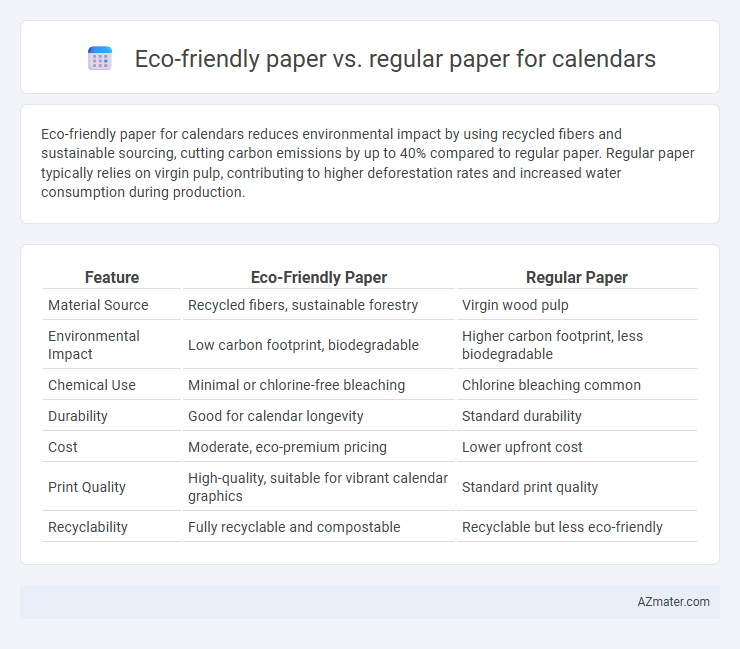Eco-friendly paper for calendars reduces environmental impact by using recycled fibers and sustainable sourcing, cutting carbon emissions by up to 40% compared to regular paper. Regular paper typically relies on virgin pulp, contributing to higher deforestation rates and increased water consumption during production.
Table of Comparison
| Feature | Eco-Friendly Paper | Regular Paper |
|---|---|---|
| Material Source | Recycled fibers, sustainable forestry | Virgin wood pulp |
| Environmental Impact | Low carbon footprint, biodegradable | Higher carbon footprint, less biodegradable |
| Chemical Use | Minimal or chlorine-free bleaching | Chlorine bleaching common |
| Durability | Good for calendar longevity | Standard durability |
| Cost | Moderate, eco-premium pricing | Lower upfront cost |
| Print Quality | High-quality, suitable for vibrant calendar graphics | Standard print quality |
| Recyclability | Fully recyclable and compostable | Recyclable but less eco-friendly |
Introduction: The Importance of Sustainable Calendars
Sustainable calendars play a crucial role in reducing environmental impact by utilizing eco-friendly paper made from recycled fibers or sustainably sourced materials. Eco-friendly paper significantly lowers carbon footprint and deforestation compared to regular paper, which often relies on virgin pulp from non-renewable resources. Choosing eco-friendly paper for calendars supports conservation efforts and promotes responsible consumption in everyday products.
What is Eco-Friendly Paper?
Eco-friendly paper for calendars is produced using sustainable materials such as recycled fibers or scraps from agricultural waste, significantly reducing deforestation and environmental impact. Unlike regular paper, it often involves chlorine-free bleaching processes and lower energy consumption, which decreases carbon emissions and pollution. This type of paper is biodegradable and recyclable, making it a responsible choice for environmentally conscious consumers seeking sustainable alternatives.
Regular Paper: Composition and Environmental Impact
Regular paper for calendars is primarily composed of wood pulp derived from virgin trees, often bleached with chlorine-based chemicals, contributing to its environmental footprint. The production process involves significant water and energy consumption, resulting in higher greenhouse gas emissions compared to recycled alternatives. Disposal of regular paper frequently leads to increased landfill waste, as it decomposes slowly and may release methane, a potent greenhouse gas, highlighting its less eco-friendly impact.
Production Process: Eco-Friendly vs Regular Paper
Eco-friendly paper production utilizes sustainable raw materials such as recycled fibers and plantation-grown trees, significantly reducing deforestation and carbon footprint compared to regular paper. The manufacturing process for eco-friendly paper often employs chlorine-free bleaching and lower water consumption, minimizing harmful chemical discharge and environmental pollution. In contrast, regular paper production relies heavily on virgin wood pulp and chemical-intensive treatments, resulting in higher energy use and greater waste generation.
Resource Consumption: Water, Energy, and Raw Materials
Eco-friendly paper for calendars significantly reduces resource consumption by utilizing recycled fibers or sustainably sourced materials, cutting water usage by up to 50% compared to regular paper production. Energy consumption also drops due to more efficient manufacturing processes and fewer chemical treatments in eco-friendly options. Regular paper relies heavily on virgin wood pulp, leading to higher demand for raw materials and increased environmental impact.
Chemical Usage and Pollution
Eco-friendly paper for calendars significantly reduces chemical usage by minimizing harmful bleaching agents and opting for natural or recycled fibers, unlike regular paper, which often relies on chlorine-based bleach and synthetic additives. This reduction in chemicals leads to lower environmental pollution, including decreased water contamination and fewer toxic emissions during production. Choosing eco-friendly paper supports sustainable calendar manufacturing by preserving ecosystems and reducing the overall carbon footprint associated with paper production.
Biodegradability and End-of-Life Options
Eco-friendly paper used for calendars is typically made from recycled fibers or sustainably sourced materials, enhancing its biodegradability compared to regular paper. This type of paper decomposes faster in natural environments, reducing landfill waste and environmental impact. End-of-life options for eco-friendly calendar paper include composting and recycling, whereas regular paper often ends up in landfills due to the lack of sustainable processing or coatings.
Cost Comparison: Eco-Friendly vs Regular Paper Calendars
Eco-friendly paper calendars typically incur higher initial costs due to sustainable sourcing and production methods, ranging from 15% to 30% more expensive than regular paper options. Regular paper calendars benefit from established mass production economies, reducing per-unit expenses but often at the environmental cost of deforestation and chemical usage. Long-term cost savings with eco-friendly calendars emerge through durability and consumer preference for green products, which can enhance brand value despite the premium price.
Environmental Certifications and Standards
Eco-friendly paper used for calendars often holds certifications such as FSC (Forest Stewardship Council) and PEFC (Programme for the Endorsement of Forest Certification), ensuring sustainable forestry practices and responsible sourcing. These papers typically comply with environmental standards like ISO 14001 for environmental management, significantly reducing carbon footprint and chemical usage compared to regular paper. In contrast, regular paper generally lacks these certifications, contributing to deforestation, higher energy consumption, and increased pollution during production.
Making the Switch: Choosing the Right Paper for Your Calendar
Choosing eco-friendly paper for your calendar reduces environmental impact through sustainable sourcing, lower carbon emissions, and biodegradability, compared to regular paper made from virgin pulp and chemical-intensive processing. Eco-friendly calendars often use recycled fibers, soy-based inks, and chlorine-free bleaching, ensuring a healthier alternative that aligns with green practices. Switching to this paper type supports corporate social responsibility initiatives while maintaining print quality and durability for everyday use.

Infographic: Eco-friendly paper vs Regular paper for Calendar
 azmater.com
azmater.com